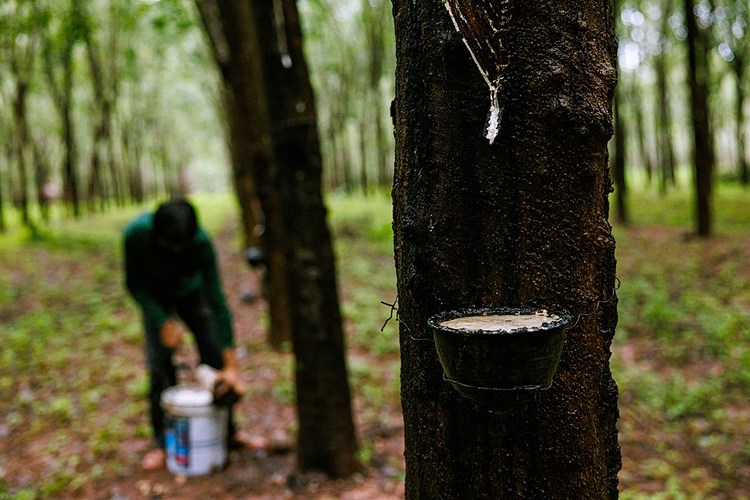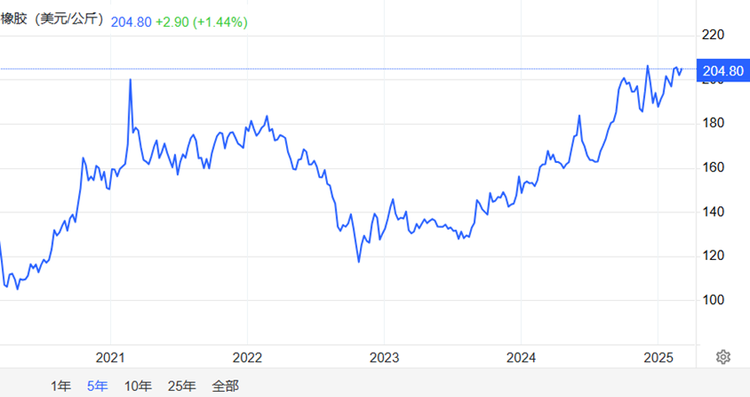Is there still a big market for rubber products? International association warns of a fifth consecutive year of rubber supply shortage
①International rubber prices continue to rise, and the Association of Natural Rubber Producing Countries (ANRPC) expects that in 2025, global natural rubber production will be below consumption for the fifth consecutive year;
②Thailand, as the largest producer, is expected to further reduce supply, while demand from consuming countries such as China and India continues to grow;
③Since the beginning of this year, the price of rubber futures has risen by nearly 4%, and the shortage in rubber production also means an increase in tire prices.

Cailian, March 5 (Editor Ma Lan) International rubber prices are showing an upward trend again, with prices fluctuating within a historically high range, and there is concern in the market that prices will continue to rise.
Senior economist Lekshmi Nair of the Association of Natural Rubber Producing Countries (ANRPC) said on Wednesday that it is expected that in 2025, global natural rubber production will be below consumption for the fifth consecutive year. Demand from countries like China, India, and Thailand has been growing, but last year's prices were not attractive enough to encourage expansion, resulting in the current lag in global rubber production.
Meanwhile, the largest producer, Thailand, is expected to further reduce its supply. According to warnings from the Thai Meteorological Department, localized thunderstorms may occur in southern Thailand over the weekend, potentially damaging rubber trees and other crops.
On the other hand, the tariff war initiated by the United States could cause short-term chaos in international trade, and some industry insiders are concerned that it might limit demand from China, the largest buyer of rubber.
According to Trading Economics data, the current price of rubber futures is about 205 cents per kilogram, and so far this year, the price of this commodity has increased by nearly 4%.

Supply Shortage
Nair pointed out that the current rubber shortage is due to low prices over the past seven or eight years, which have discouraged many farmers in producing countries from replanting or planting new rubber trees. They have instead turned to more profitable crops, such as oil palms.
However, abnormal weather in recent years has led to poor harvests of many agricultural products, including oil palm, coffee beans, and cocoa, all of which saw price surges last year. Rubber also set a new price record in the last quarter of last year.
But according to ANRPC estimates, global rubber production this year will increase by 0.3% to 14.9 million tons, while demand will grow at a faster rate of 1.8% to 15.6 million tons.
Rubber is a key raw material for tires, and a shortage in rubber production will help maintain firm tire prices, which hit a 13-year high at the end of last year.
【Copyright and Disclaimer】The above information is collected and organized by PlastMatch. The copyright belongs to the original author. This article is reprinted for the purpose of providing more information, and it does not imply that PlastMatch endorses the views expressed in the article or guarantees its accuracy. If there are any errors in the source attribution or if your legitimate rights have been infringed, please contact us, and we will promptly correct or remove the content. If other media, websites, or individuals use the aforementioned content, they must clearly indicate the original source and origin of the work and assume legal responsibility on their own.
Most Popular
-

List Released! Mexico Announces 50% Tariff On 1,371 China Product Categories
-

Nissan Cuts Production of New Leaf EV in Half Due to Battery Shortage
-

New Breakthrough in Domestic Adiponitrile! Observing the Rise of China's Nylon Industry Chain from Tianchen Qixiang's Production
-

Dow, Wanhua, Huntsman Intensively Raise Prices! Who Controls the Global MDI Prices?
-

Mexico officially imposes tariffs on 1,400 chinese products, with rates up to 50%






